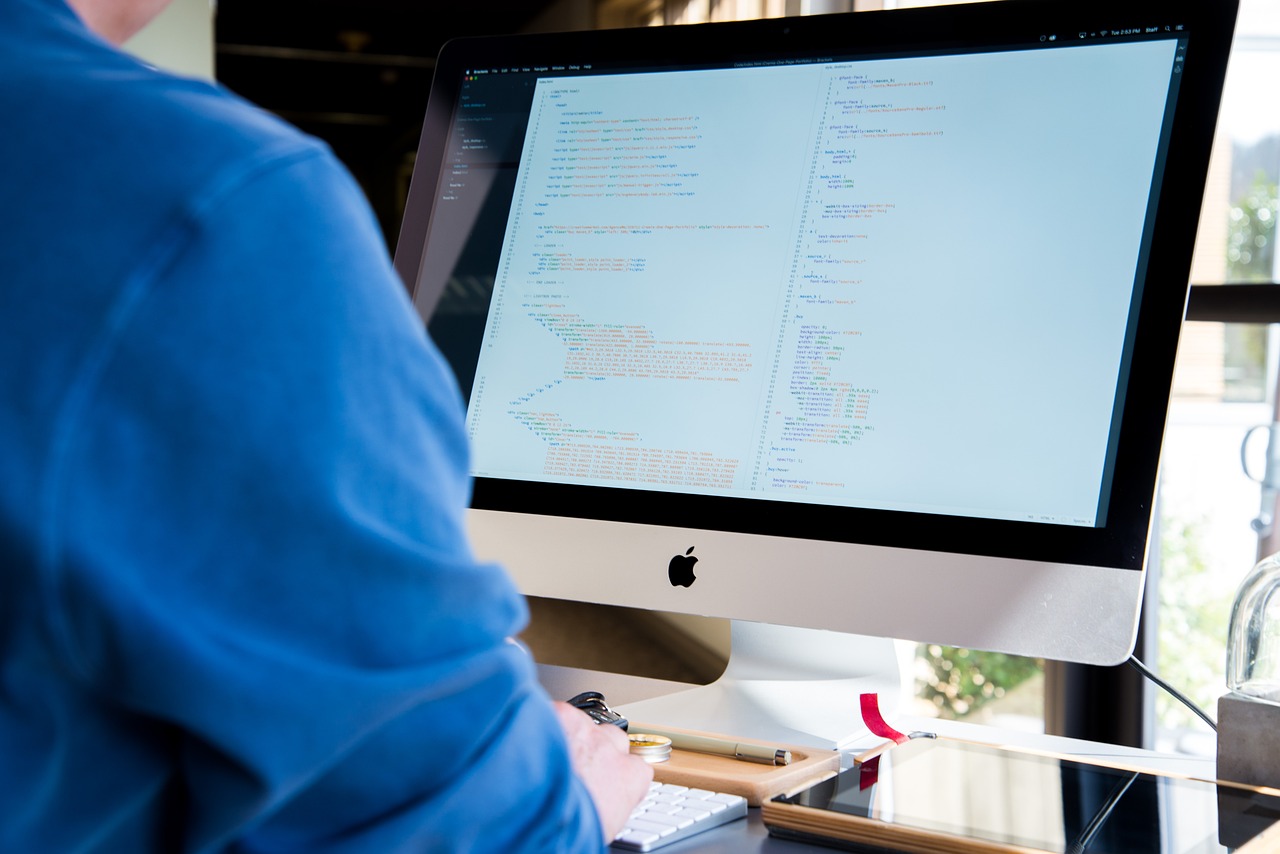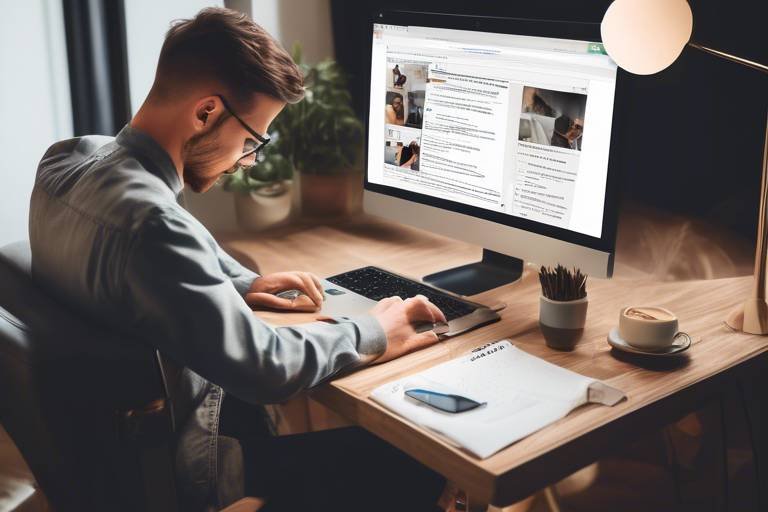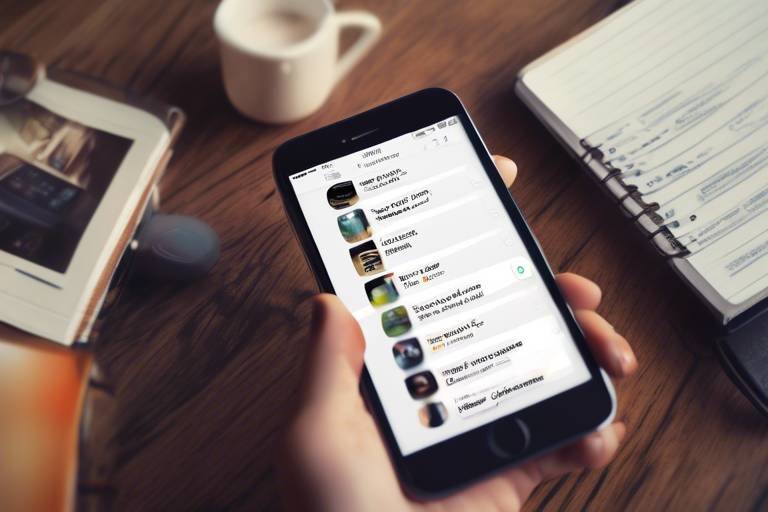Designing a Workspace That Encourages Creativity
Creating a workspace that fosters creativity is essential for boosting productivity and innovation within a company. By incorporating various elements that stimulate the mind and inspire imagination, employers can cultivate an environment where employees feel motivated and inspired to think outside the box. Let's explore some key factors that contribute to designing a workspace that encourages creativity.
One of the fundamental aspects of a creative workspace is the incorporation of natural light. Natural light not only brightens up the environment but also has a positive impact on mood and productivity. By allowing ample sunlight to flow into the workspace, employees can feel more energized and focused, leading to enhanced creativity in their work.
Flexible furniture arrangements play a crucial role in creating a dynamic workspace that caters to different work styles. By offering a mix of collaborative spaces and individual workstations, employees have the freedom to choose an environment that best suits their creative process. This versatility promotes teamwork and idea sharing while also allowing for focused individual work.
Color has the power to influence emotions and creativity. Choosing stimulating colors for walls and decor can evoke specific feelings and inspire innovative thinking among employees. Vibrant hues can create a lively atmosphere, while calming tones can promote relaxation and concentration. By carefully selecting color schemes, employers can set the tone for a creative workspace.
Bringing elements of nature into the workspace, such as plants and natural materials, can have a profound impact on employee well-being and creativity. Studies have shown that being surrounded by nature can reduce stress levels, increase focus, and spark creativity. Integrating greenery and natural elements into the office design can create a rejuvenating environment that stimulates the imagination.
Allowing employees to personalize their workstations can enhance their sense of ownership and creativity. Personalized spaces reflect individual preferences and personality, making employees feel more connected to their work environment. By encouraging personalization, employers can empower their staff to express themselves creatively and feel inspired in their workspace.
Designing dedicated breakout areas with stimulating elements like games, art, or comfortable seating can provide employees with a space to relax and recharge their creativity. These areas serve as a retreat from the regular work environment, allowing employees to unwind and brainstorm ideas in a more casual setting. Creative breakout areas foster a sense of playfulness and exploration, essential for nurturing creativity.
Integrating the latest technology tools and gadgets into the workspace can streamline processes and inspire innovative thinking. Technology enables employees to collaborate more efficiently, access information quickly, and experiment with new ideas. By embracing technological advancements, employers can create a dynamic and forward-thinking environment that fuels creativity and problem-solving.
Controlling noise levels in the workspace is crucial for maintaining a conducive environment for creativity. Implementing soundproofing solutions or establishing designated quiet zones can help minimize distractions and promote focus. By managing noise effectively, employers can create a peaceful atmosphere where employees can concentrate on their creative tasks without disruption.
Designing open and inviting collaborative spaces encourages teamwork, idea sharing, and cross-pollination of creative thoughts. Collaborative areas with comfortable seating, whiteboards, and brainstorming tools facilitate communication and collaboration among employees. By creating a space where ideas can flow freely, employers can nurture a culture of innovation and creativity within the organization.

Utilizing Natural Light
When it comes to creating a workspace that sparks creativity and innovation, several key elements play a crucial role. From the layout of furniture to the color schemes on the walls, every detail can impact the overall ambiance of the workspace. Let's delve into some essential factors that can help in designing a workspace that fosters creativity and productivity.
Embracing natural light in the workspace is like infusing a burst of energy into the environment. Sunlight has the power to uplift moods, increase focus, and enhance productivity. By strategically placing workstations near windows or incorporating skylights, you can ensure that employees benefit from the positive effects of natural light throughout the day. Natural light not only reduces the reliance on artificial lighting but also creates a vibrant and dynamic atmosphere that stimulates creativity.

Flexible Furniture Arrangements
Utilizing Natural Light - Incorporating natural light into the workspace can boost mood and productivity, fostering a more creative environment for employees.
- When it comes to creating a workspace that encourages creativity, the arrangement of furniture plays a crucial role. By adopting flexible furniture layouts, you can cater to different work styles and needs within your team. Imagine a space where desks and chairs can easily be rearranged to accommodate collaborative projects or provide individual workstations for focused tasks. This versatility not only promotes creativity but also fosters a dynamic and adaptable work environment where innovation can thrive.
Inspiring Color Schemes - Choosing the right colors for your workspace can have a significant impact on creativity. Vibrant and stimulating color schemes can evoke specific emotions and enhance the overall mood of employees. By incorporating colors that inspire creativity and positivity, you can create a visually appealing environment that sparks innovative thinking and encourages out-of-the-box solutions.
Incorporating Nature Elements - Bringing elements of nature into the workspace can have a calming effect on employees, reducing stress levels and boosting creativity. Imagine lush green plants scattered throughout the office, providing a breath of fresh air and a connection to the outdoors. By integrating nature elements such as plants, natural materials, or even a small indoor garden, you can create a more relaxing and inspiring work environment that promotes creativity and well-being.
Personalized Workstations - Allowing employees to personalize their workstations can create a sense of ownership and belonging, fostering creativity and motivation. Imagine a workspace where each desk reflects the personality and preferences of its occupant, with photos, artwork, or unique decor items that inspire creativity and productivity. By giving employees the freedom to customize their workstations, you empower them to create a space that resonates with their individuality and fuels their creativity.
Creative Breakout Areas - Designing dedicated breakout areas within the workspace can provide employees with a space to relax, recharge, and spark creativity. Imagine a cozy corner filled with comfortable seating, inspiring artwork, and engaging activities like puzzles or board games. These creative breakout areas offer employees a chance to unwind, brainstorm ideas, and collaborate in a more casual and stimulating environment, enhancing creativity and fostering innovation.
Technology Integration - Incorporating the latest technology tools and gadgets into the workspace can streamline processes and inspire innovative thinking among employees. Imagine a workspace equipped with state-of-the-art devices, interactive displays, and digital tools that facilitate collaboration and creativity. By embracing technology and integrating it seamlessly into the work environment, you can empower your team to work more efficiently, communicate effectively, and explore new ideas with ease.
Noise Management Strategies - Managing noise levels in the workspace is essential for creating a conducive environment where creativity can flourish. Implementing soundproofing solutions, designated quiet zones, or noise-canceling technologies can help control distractions and provide employees with a focused and peaceful work environment. Imagine a workspace where noise is minimized, allowing employees to concentrate, brainstorm, and collaborate without disruptions, ultimately enhancing creativity and productivity.
Collaborative Spaces Design - Designing open and inviting collaborative spaces within the workspace can foster idea sharing, teamwork, and the cross-pollination of creative thoughts. Imagine a shared area with flexible seating arrangements, interactive whiteboards, and project collaboration tools that encourage spontaneous discussions and brainstorming sessions. By creating collaborative spaces that inspire communication and creativity, you can cultivate a culture of innovation and collaboration within your team.

Inspiring Color Schemes
When it comes to designing a workspace that encourages creativity, one crucial aspect to consider is the use of . The colors surrounding us have a significant impact on our mood, emotions, and productivity. By carefully selecting the right color palette for the workspace, employers can create an environment that stimulates creativity and enhances the overall well-being of employees.
Research has shown that different colors can evoke specific emotions and behaviors. For example, warm tones like red and orange can promote energy and passion, while cool tones like blue and green can have a calming effect and enhance focus. By strategically incorporating these colors into the workspace, employers can create a dynamic and inspiring atmosphere that motivates employees to think creatively and perform at their best.
Moreover, the use of complementary color schemes can create visual interest and harmony in the workspace. Pairing colors that are opposite each other on the color wheel, such as blue and orange or purple and yellow, can create a vibrant and stimulating environment that sparks creativity and innovation.
It's essential to consider the psychological effects of colors when designing the workspace. For instance, yellow is often associated with happiness and optimism, making it a great choice for areas where brainstorming and ideation take place. On the other hand, green is linked to nature and tranquility, ideal for promoting a sense of calm and balance in the workspace.
By carefully selecting and integrating inspiring color schemes into the workspace, employers can create a visually appealing environment that not only enhances creativity but also boosts employee morale and engagement.

Incorporating Nature Elements
When it comes to designing a workspace that encourages creativity, incorporating nature elements can play a crucial role in creating a harmonious and inspiring environment for employees. By integrating plants, natural light, and other elements of nature into the workspace, employers can significantly impact the well-being and creativity of their staff.
Plants have been proven to have a positive effect on reducing stress levels and increasing focus among individuals. By strategically placing greenery throughout the office, employees can experience a sense of calmness and connection to nature, which can in turn enhance their creativity and overall productivity. Additionally, plants can improve air quality, creating a healthier and more pleasant work environment.
Furthermore, natural elements such as wood accents, stone features, or even water elements like fountains or aquariums can add a touch of tranquility and serenity to the workspace. These elements can help employees feel more grounded and inspired, fostering a creative mindset that is essential for innovative thinking and problem-solving.
Studies have shown that exposure to nature, even in an indoor setting, can have a positive impact on mental well-being and cognitive function. By bringing elements of the outdoors inside, employers can create a space that promotes relaxation, focus, and creativity among their employees.

Personalized Workstations
Personalized workstations play a crucial role in fostering creativity within a workspace. When employees have the freedom to customize their own work areas, it creates a sense of ownership and belonging. This personal touch can significantly boost morale and motivation, leading to increased productivity and creativity.
Imagine walking into a workspace where each desk reflects the unique personality and style of its occupant. From family photos to inspirational quotes, personalized workstations not only showcase individuality but also serve as constant sources of motivation. This customization allows employees to create a space that resonates with them personally, sparking creativity and innovation.
Moreover, personalized workstations can enhance comfort and ergonomics, as employees can tailor their setup to suit their preferences. Whether it's adjusting the height of their chair or organizing their desk layout, these personalized touches contribute to a more comfortable and efficient working environment. A happy and comfortable employee is more likely to think creatively and contribute positively to the overall workspace atmosphere.
Collaboration and teamwork are also encouraged through personalized workstations. By allowing employees to showcase their interests and passions through their workspace, it opens up opportunities for conversation and connection with colleagues. Sharing personal touches can lead to bonding over shared interests, fostering a sense of community and collaboration within the workspace.
Incorporating a variety of elements in personalized workstations, such as plants, artwork, or unique desk accessories, can further stimulate creativity and inspiration. These personal touches can serve as conversation starters, sparking new ideas and encouraging a vibrant exchange of thoughts among employees. Ultimately, personalized workstations contribute to a dynamic and creative workspace that nurtures innovation and collaboration.

Creative Breakout Areas
When it comes to fostering creativity in the workplace, having designated creative breakout areas can make a significant impact. These spaces are not just for taking a break but are designed to stimulate creativity and relaxation simultaneously. Imagine a corner of the office transformed into a mini oasis where employees can unwind, recharge, and let their creative juices flow freely. It's like a hidden gem within the workspace, waiting to be discovered.
These breakout areas can be equipped with various elements to inspire creativity. From colorful bean bags to intriguing puzzles, from vibrant artwork to inspirational quotes, every detail is carefully curated to spark imagination and innovation. Employees can step into these areas and feel a sense of liberation from the usual work routine, allowing their minds to wander and explore new ideas.
Picture a cozy nook with comfortable seating, surrounded by lush green plants and soft ambient lighting. This setting not only provides a change of scenery but also a change of mindset. It's a space where employees can brainstorm, collaborate, or simply unwind, all while being immersed in a creative atmosphere that fuels their imagination.
Moreover, these breakout areas can serve as a hub for spontaneous discussions and brainstorming sessions. Imagine colleagues gathering around a table, engaged in a lively conversation, bouncing ideas off each other, and igniting a spark of creativity that leads to innovative solutions. It's a space where collaboration thrives, and creativity knows no bounds.
By incorporating creative breakout areas into the workspace, employers can demonstrate their commitment to nurturing creativity and innovation among employees. These spaces not only provide a refreshing retreat from the daily grind but also serve as a reminder that creativity is valued and encouraged in the organization. After all, sometimes all it takes is a change of scenery to inspire the next big idea.

Technology Integration
When it comes to fostering creativity in the workplace, integrating the latest technology tools and gadgets plays a crucial role. Technology integration not only streamlines processes but also inspires innovative thinking among employees. By incorporating cutting-edge devices and software, companies can create an environment that encourages creativity and boosts productivity.
Imagine a workspace where employees have access to state-of-the-art equipment that simplifies their tasks and allows them to explore new ideas effortlessly. From high-speed computers to interactive displays, technology integration opens up a world of possibilities for collaboration and problem-solving. By leveraging digital tools, employees can unleash their creativity and bring fresh perspectives to projects.
Moreover, technology integration enables seamless communication and information sharing within the organization. With instant messaging platforms, video conferencing tools, and project management software, teams can collaborate effectively regardless of their physical location. This interconnectedness fosters a sense of community and encourages brainstorming sessions that lead to innovative solutions.
Additionally, the use of virtual reality (VR) and augmented reality (AR) in the workspace can take creativity to new heights. By immersing employees in virtual environments or overlaying digital information onto the physical world, these technologies spark imagination and inspire out-of-the-box thinking. Whether it's designing prototypes or visualizing complex data, VR and AR offer endless possibilities for creative exploration.
Furthermore, technology integration paves the way for automation and efficiency in everyday tasks. By implementing workflow automation tools and AI-powered solutions, employees can focus on high-value creative work rather than repetitive processes. This not only enhances productivity but also frees up time for innovation and experimentation.
In conclusion, technology integration is a cornerstone of designing a workspace that encourages creativity. By embracing the latest tech trends and providing employees with the tools they need to excel, organizations can cultivate a culture of innovation and ingenuity. From enhancing collaboration to empowering individual creativity, technology integration is a catalyst for unlocking the full creative potential of employees.

Noise Management Strategies
When it comes to creating a workspace that fosters creativity, managing noise levels is crucial. Excessive noise can be a major distraction and hinder the creative flow of employees. Implementing effective noise management strategies can help maintain a peaceful and productive environment where ideas can flourish.
One strategy to control noise is through the use of soundproofing materials. Installing sound-absorbing panels on walls or ceilings can help reduce echoes and minimize external disturbances. Additionally, providing employees with noise-canceling headphones can offer a personalized solution to block out unwanted sounds and focus on their tasks.
Designating quiet zones within the workspace is another effective approach to noise management. These areas can serve as retreats for employees seeking a peaceful environment to concentrate or engage in deep thinking. By creating designated quiet spaces, employees can escape the hustle and bustle of the main workspace and find solace in a serene setting conducive to creativity.
Furthermore, establishing clear guidelines on acceptable noise levels and behavior can help maintain a harmonious work environment. Encouraging respectful communication among employees regarding noise sensitivity and preferences can promote understanding and cooperation in managing noise effectively.
Incorporating elements of nature, such as indoor plants, can also aid in noise management. Plants not only add aesthetic value to the workspace but also act as natural sound absorbers, helping to dampen noise levels and create a more tranquil atmosphere. Additionally, the presence of greenery can contribute to a sense of calm and well-being, enhancing the overall ambiance of the workspace.
By combining these noise management strategies, employers can create a work environment that is conducive to creativity and productivity. Addressing noise issues proactively and thoughtfully can help employees focus, collaborate, and unleash their innovative potential without being disrupted by unwanted sounds.

Collaborative Spaces Design
Collaborative spaces design plays a pivotal role in fostering creativity and innovation within a workspace. These areas are carefully crafted to encourage interaction, idea sharing, and teamwork among employees. By creating open and inviting spaces, organizations can facilitate the cross-pollination of creative thoughts, leading to the development of unique and groundbreaking ideas. Collaborative spaces are designed to break down barriers and hierarchies, allowing individuals from various departments and levels of the organization to come together and collaborate seamlessly.
One effective way to enhance collaborative spaces is through the strategic placement of furniture and amenities. By incorporating comfortable seating arrangements, communal workstations, and interactive whiteboards, employees are encouraged to brainstorm, discuss, and ideate collectively. These spaces are often equipped with technology tools that facilitate seamless communication and idea sharing, further enhancing the collaborative experience. Additionally, the design elements within these spaces are carefully curated to inspire creativity and promote a sense of community among employees.
Moreover, the aesthetics of collaborative spaces play a crucial role in setting the tone for productive interactions. Thoughtfully chosen colors, lighting, and decor can create a welcoming and energizing atmosphere that motivates employees to engage in collaborative activities. By integrating elements of nature, such as plants or natural materials, these spaces can evoke a sense of calm and creativity, enhancing the overall collaborative experience.
Furthermore, the layout and flexibility of collaborative spaces are designed to cater to different work styles and preferences. Whether employees prefer to work in groups, pairs, or individually, these spaces offer a variety of settings to accommodate diverse needs. By providing a mix of private nooks, open meeting areas, and breakout zones, organizations can ensure that employees have the freedom to choose their ideal space for collaboration, leading to increased productivity and creativity.
In conclusion, collaborative spaces design is a key component of creating a workspace that encourages creativity and innovation. By thoughtfully designing these areas to promote collaboration, communication, and community, organizations can harness the collective creativity of their employees and drive meaningful progress towards their goals.
Frequently Asked Questions
- How can natural light benefit a workspace?
Natural light can boost mood and productivity, creating a more positive and energizing environment that fosters creativity among employees.
- Why are flexible furniture arrangements important for a creative workspace?
Flexible furniture layouts cater to different work styles, allowing for both collaborative spaces and individual workstations, which in turn promotes creativity and innovation.
- How do inspiring color schemes contribute to creativity in the workspace?
Stimulating colors on walls and decor can evoke specific emotions and enhance creativity among employees by creating a visually engaging and inspiring atmosphere.
- What benefits do nature elements bring to a workspace?
Integrating plants and natural elements can reduce stress, increase focus, and spark creativity among employees, creating a more calming and productive work environment.
- Why is personalizing workstations important for creativity?
Allowing employees to personalize their workstations fosters a sense of ownership and inspiration, leading to enhanced creativity and a more engaging work experience.
- How do creative breakout areas contribute to a productive workspace?
Designing breakout areas with stimulating elements like games or art can encourage relaxation, boost creativity during breaks, and foster a more dynamic work environment.
- Why is technology integration crucial for inspiring innovative thinking?
Integrating the latest technology tools in the workspace streamlines processes and encourages employees to think innovatively, leading to more efficient and creative work practices.
- What role do noise management strategies play in a creative workspace?
Implementing soundproofing solutions or quiet zones helps control noise levels, creating a conducive environment for creativity to flourish by minimizing distractions.
- How do collaborative spaces enhance creativity among employees?
Creating open and inviting collaborative spaces encourages idea sharing, teamwork, and the cross-pollination of creative thoughts, fostering a culture of innovation and creativity in the workspace.



















